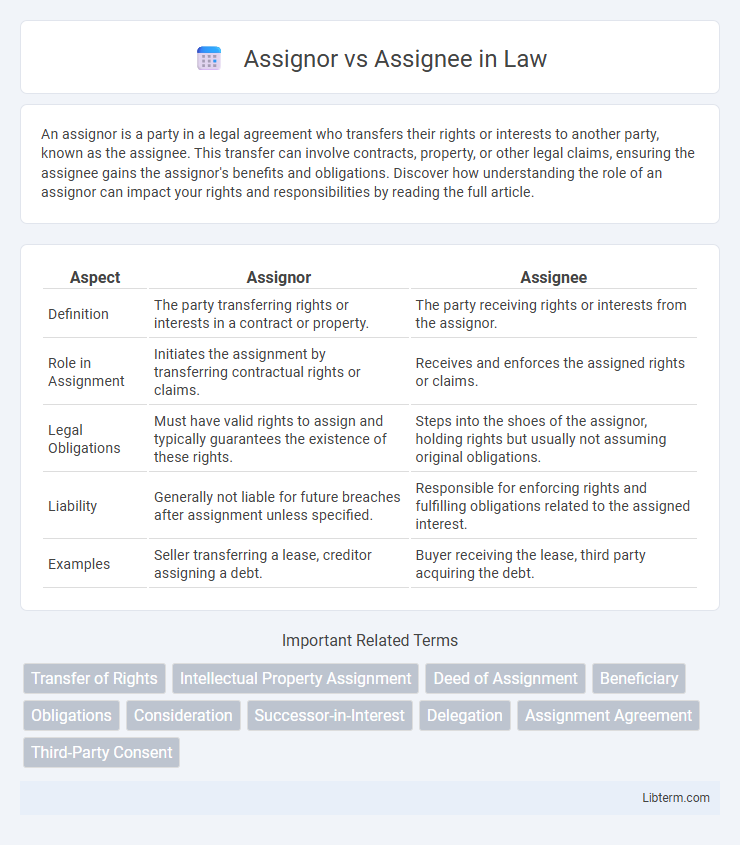An assignor is a party in a legal agreement who transfers their rights or interests to another party, known as the assignee. This transfer can involve contracts, property, or other legal claims, ensuring the assignee gains the assignor's benefits and obligations. Discover how understanding the role of an assignor can impact your rights and responsibilities by reading the full article.
Table of Comparison
| Aspect | Assignor | Assignee |
|---|---|---|
| Definition | The party transferring rights or interests in a contract or property. | The party receiving rights or interests from the assignor. |
| Role in Assignment | Initiates the assignment by transferring contractual rights or claims. | Receives and enforces the assigned rights or claims. |
| Legal Obligations | Must have valid rights to assign and typically guarantees the existence of these rights. | Steps into the shoes of the assignor, holding rights but usually not assuming original obligations. |
| Liability | Generally not liable for future breaches after assignment unless specified. | Responsible for enforcing rights and fulfilling obligations related to the assigned interest. |
| Examples | Seller transferring a lease, creditor assigning a debt. | Buyer receiving the lease, third party acquiring the debt. |
Understanding Assignor and Assignee
An assignor is the party who transfers rights or interests in a contract or property to another entity, while the assignee is the individual or organization receiving those rights or interests. Understanding the roles involves recognizing that the assignor initiates the assignment by conveying legal rights, and the assignee assumes those rights, obligations, or benefits under the agreement. The clarity between assignor and assignee is crucial in legal transactions to ensure proper enforcement and responsibility distribution.
Key Definitions: Assignor vs Assignee
An assignor is the party who transfers their rights or interests in a contract or property to another party. The assignee is the recipient of those rights or interests, gaining the legal ability to enforce or benefit from the assigned rights. Understanding the roles of assignor and assignee is crucial in contract law to ensure proper transfer and acceptance of contractual obligations or property rights.
Legal Roles in an Assignment
The assignor is the original party who transfers rights or interests under a contract to another party, the assignee, who receives and assumes those rights and obligations. In legal assignments, the assignor must have valid rights to assign, while the assignee gains enforceable claims against the obligor once the assignment is effective. Proper documentation is crucial to define the scope of rights transferred and to protect both parties in disputes or enforcement actions.
Rights and Responsibilities of an Assignor
The assignor holds the responsibility to transfer contractual rights or obligations to the assignee while ensuring the original agreement's validity and efficacy. The assignor must guarantee that the rights being assigned are free from encumbrances and that they provide all necessary documentation for the transfer. Failure to fulfill these responsibilities may result in the assignor remaining liable for any breaches or unfulfilled obligations under the original contract.
Duties and Obligations of an Assignee
The assignee assumes the rights and obligations stipulated in the original contract, including timely performance and adherence to all terms. Responsibilities extend to notifying the obligor of the assignment to ensure enforceability and conducting due diligence to avoid potential liabilities. Failure to fulfill these duties can result in breach of contract and legal consequences.
Differences Between Assignor and Assignee
The assignor is the party who transfers rights or interests under a contract to another party, while the assignee is the party who receives those rights or interests. The assignor retains responsibility for obligations before the transfer, whereas the assignee assumes rights and duties moving forward. Legal frameworks often require clear identification of assignor and assignee to ensure enforceability and proper contract performance.
Common Types of Assignments
Common types of assignments include contract assignments, lease assignments, and intellectual property assignments, where the assignor transfers rights or obligations to the assignee. In contract assignments, the assignor transfers contract benefits or duties, often seen in service agreements or sales contracts. Lease assignments involve transferring tenant rights to another party, while intellectual property assignments transfer rights to patents, copyrights, or trademarks.
Legal Implications for Assignors and Assignees
Assignors transfer contractual rights or obligations to assignees, which legally shifts responsibilities and benefits from the assignor to the assignee, often requiring formal consent to ensure enforceability. Assignees assume all legal rights and liabilities attached to the assigned contract, making them responsible for performance and subject to potential breaches or disputes arising from the agreement. Legal implications for assignors include release from future obligations upon valid assignment, while assignees must navigate risks of incomplete disclosure or defects in the original contract that could affect enforceability.
Examples and Case Studies
In contract law, the assignor transfers rights or interests under an agreement to the assignee, who then assumes those rights. For example, in a lease assignment case, the assignor (tenant) transfers their leasehold interest to the assignee (new tenant), who becomes responsible for rent payments, as seen in the landmark case of *Landlord & Tenant Co. v. Smith*. Case studies of intellectual property assignments highlight that the assignor must clearly specify rights transferred to avoid disputes, demonstrated by the *Apple Inc. v. Samsung Electronics* patent assignment disputes.
Frequently Asked Questions: Assignors vs Assignees
Assignors transfer rights or interests under a contract to assignees, who then receive and assume those rights and obligations. Common FAQs address the legality of assignments, notifying the obligor, and the assignee's ability to enforce rights, with most jurisdictions requiring clear consent for valid transfer. Understanding the distinctions ensures proper contract management and protects both parties' legal interests.
Assignor Infographic

 libterm.com
libterm.com